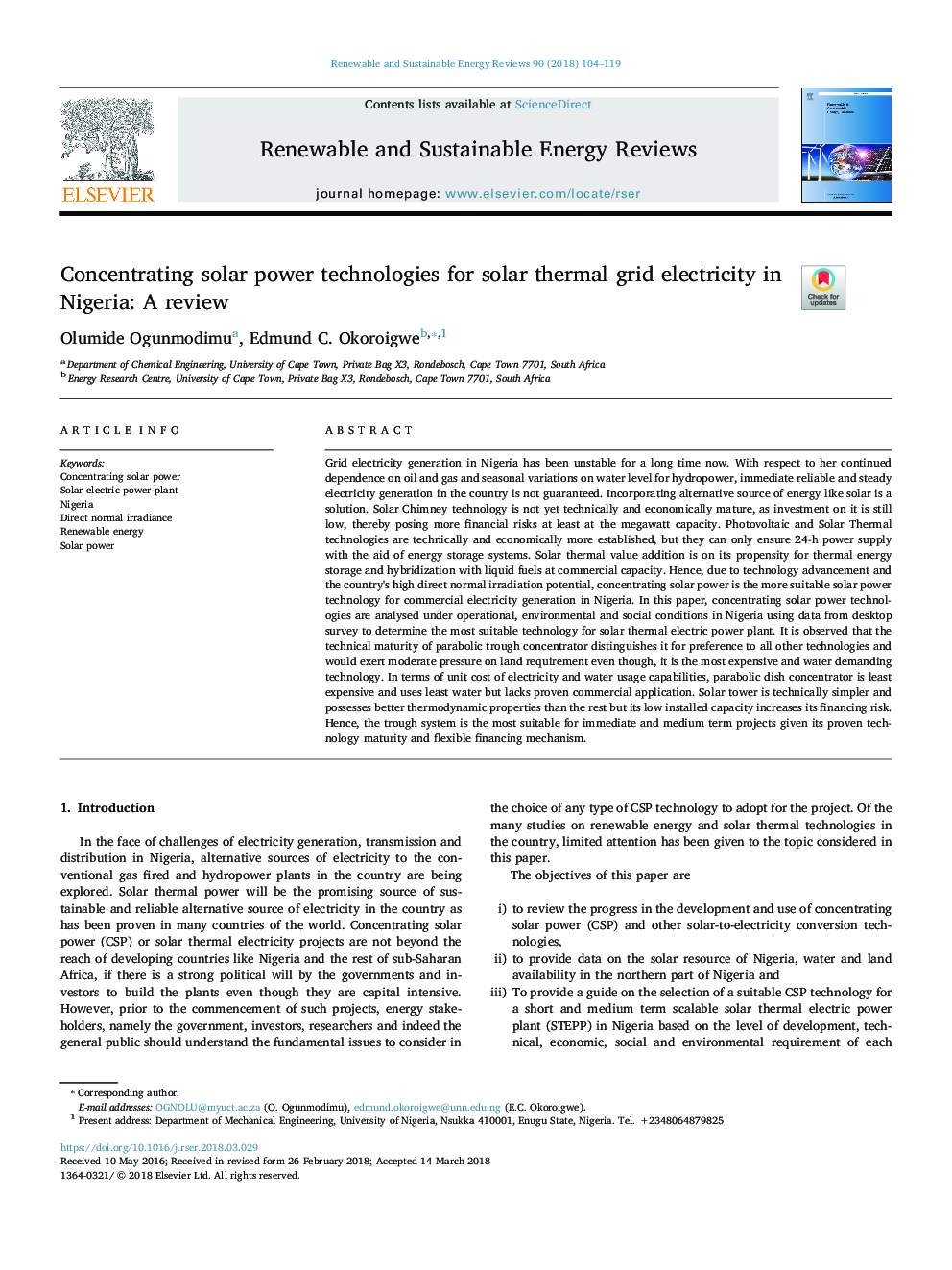| کد مقاله | کد نشریه | سال انتشار | مقاله انگلیسی | نسخه تمام متن |
|---|---|---|---|---|
| 8111175 | 1522294 | 2018 | 16 صفحه PDF | دانلود رایگان |
عنوان انگلیسی مقاله ISI
Concentrating solar power technologies for solar thermal grid electricity in Nigeria: A review
ترجمه فارسی عنوان
تمرکز فن آوری های انرژی خورشیدی برای برق خورشیدی گرمایش در نیجریه: بررسی
دانلود مقاله + سفارش ترجمه
دانلود مقاله ISI انگلیسی
رایگان برای ایرانیان
کلمات کلیدی
غلظت انرژی خورشیدی، نیروگاه برق خورشیدی، نیجریه، تابش نور مستقیم، انرژی تجدید پذیر، نیروی خورشیدی،
ترجمه چکیده
تولید برق گرید در نیجریه برای مدت طولانی ناپایدار است. با توجه به ادامه وابستگی خود به نفت و گاز و تغییرات فصلی در سطح آب برای نیروگاه های آبی، تولید برق مستقیم و پایدار در کشور تضمین نمی شود. جایگزینی انرژی جایگزین مانند انرژی خورشیدی یک راه حل است. فناوری دودکش خورشیدی هنوز از لحاظ فنی و اقتصادی بالغ نیست، زیرا سرمایه گذاری در آن هنوز هم کم است، در نتیجه حداقل خطرات مالی در ظرفیت مگاوات ایجاد می شود. فن آوری های فوتوولتائیک و حرارتی خورشیدی از لحاظ فنی و اقتصادی پایدار تر است، اما آنها تنها می توانند از منبع تغذیه 24 ساعته با کمک سیستم های ذخیره انرژی تامین کنند. علاوه بر این، علاوه بر ارزش حرارتی خورشیدی، تمایل به ذخیره انرژی حرارتی و همکاری با سوخت های مایع در ظرفیت تجاری است. از این رو، با توجه به پیشرفت تکنولوژی و پتانسیل بالایی تابش طبیعی کشور، تمرکز نیروی خورشیدی، تکنولوژی مناسب تر انرژی خورشیدی برای تولید برق تجاری در نیجریه است. در این مقاله تمرکز تکنولوژی های خورشیدی تحت شرایط عملیاتی، محیطی و اجتماعی نیجریه با استفاده از داده های بررسی دسکتاپ برای تعیین مناسب ترین تکنولوژی برای نیروگاه خورشیدی خورشیدی مورد تجزیه و تحلیل قرار گرفته است. مشاهده شده است که بلوغ فنی انحراف معیار پارابولیک آن را برای اولویت به تمام فن آوری های دیگر متمایز می کند و فشار متوسطی را بر روی نیازهای زمین اعمال می کند، گرچه، آن است که گران تر و نیاز به تکنولوژی آب است. از لحاظ هزینه واحد برق و قابلیت استفاده از آب، غلظت غلاف پارابولیک ارزان تر است و از آب کمتری استفاده می کند اما کاربرد تجاری ثابت ندارد. برج خورشیدی از لحاظ فنی ساده تر است و دارای خواص ترمودینامیکی بهتر نسبت به بقیه است، اما ظرفیت نصب کم آن، خطر مالی آن را افزایش می دهد. از این رو، سیستم چاه مناسب ترین پروژه های فوری و متوسط است که با توجه به بلوغ تکنولوژی اثبات شده و مکانیزم تامین مالی انعطاف پذیر است.
موضوعات مرتبط
مهندسی و علوم پایه
مهندسی انرژی
انرژی های تجدید پذیر، توسعه پایدار و محیط زیست
چکیده انگلیسی
Grid electricity generation in Nigeria has been unstable for a long time now. With respect to her continued dependence on oil and gas and seasonal variations on water level for hydropower, immediate reliable and steady electricity generation in the country is not guaranteed. Incorporating alternative source of energy like solar is a solution. Solar Chimney technology is not yet technically and economically mature, as investment on it is still low, thereby posing more financial risks at least at the megawatt capacity. Photovoltaic and Solar Thermal technologies are technically and economically more established, but they can only ensure 24-h power supply with the aid of energy storage systems. Solar thermal value addition is on its propensity for thermal energy storage and hybridization with liquid fuels at commercial capacity. Hence, due to technology advancement and the country's high direct normal irradiation potential, concentrating solar power is the more suitable solar power technology for commercial electricity generation in Nigeria. In this paper, concentrating solar power technologies are analysed under operational, environmental and social conditions in Nigeria using data from desktop survey to determine the most suitable technology for solar thermal electric power plant. It is observed that the technical maturity of parabolic trough concentrator distinguishes it for preference to all other technologies and would exert moderate pressure on land requirement even though, it is the most expensive and water demanding technology. In terms of unit cost of electricity and water usage capabilities, parabolic dish concentrator is least expensive and uses least water but lacks proven commercial application. Solar tower is technically simpler and possesses better thermodynamic properties than the rest but its low installed capacity increases its financing risk. Hence, the trough system is the most suitable for immediate and medium term projects given its proven technology maturity and flexible financing mechanism.
ناشر
Database: Elsevier - ScienceDirect (ساینس دایرکت)
Journal: Renewable and Sustainable Energy Reviews - Volume 90, July 2018, Pages 104-119
Journal: Renewable and Sustainable Energy Reviews - Volume 90, July 2018, Pages 104-119
نویسندگان
Olumide Ogunmodimu, Edmund C. Okoroigwe,
